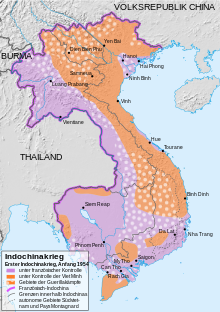Battle of Mang Yang Pass
| date | June 24 to July 17, 1954 |
|---|---|
| place | Mang Yang District , Vietnam |
| output | Victory of the Viet Minh |
| Parties to the conflict | |
|---|---|
| Commander | |
| Troop strength | |
| about 2500 men | about 2500 men |
| losses | |
|
500 dead |
147 dead, |
A series of skirmishes between colonial troops and the Viet Minh during the Indochina War in June and July 1954 was called the Battle of the Mang-Yang Pass or the Battle of An Khe or Operation Eglantine . A French unit attempted a better overland route The defended base fell back, but was almost completely destroyed in several ambushes by the Viet Minh.
background
In the central highlands , the French presence consisted of three Groupes Mobiles (GM), each in different bases. GM 42 was stationed in Pleiku , GM 41 in Ban Me Thuot , GM 100 in An Khe. The local Viet Minh, which comprised forces analogous to 10 battalions , had taken the initiative since Opération Atlante was broken off and increasingly isolated the French forces from one another. The Viet Minh were able to block the overland route from An Khe to Pleiku via Route Coloniale 19 by ambushes in the summer of 1954. An Khe was still supplied by air.
After the battle for Điện Biên Phủ, the French leadership feared the new commander-in-chief Paul Ély would further contain an advanced post. As a result, Groupe Mobile 100 was ordered to withdraw from An Khe, in the central highlands , to the safer Pleiku. This involved moving the unit around 100 kilometers on Route Coloniale 19 .
In this operation, known as Operation Eglantine , the GM 100 was to be supported by the GM 42, which was to meet the GM 100 from Pleiku on the RC 19 .
Course of operation
The Viet Minh had been informed of the French intentions the day before. As a result, the order to leave the GM 100 was given a day before the actual plan. The unit set off in four successive columns on June 24, 1954 on the RC 19. As soon as the rearguard was leaving, attacks by the Viet Minh prevented them from adhering to the schedule. At kilometer 15, the French troops were ambushed by the Viet Minh, which forced them to leave their vehicles in the early hours of the morning and move to the area next to the road. Meanwhile, the GM 42 set up a catchment position at km 22. On June 27, the two mobile groups were able to unite and march towards Pleiku as planned. After another serious ambush at the Mang Yang Pass, the surviving French reached Pleiku on June 28th. They had lost all of their artillery, 85% of their vehicles and around half of the soldiers in the GM 100. The wounded, including the colonel in command of the GM 100, had to be left behind and were taken prisoner by the Viet Minh.
historiography
In the Vietnamese literature on the Indochina War, the smashing of the GM 100 along with the skirmishes in the context of the Opération Atlante as a battle in the central highlands ( Chien Dich Tay Nguyen ) is regarded as a coherent operation.
